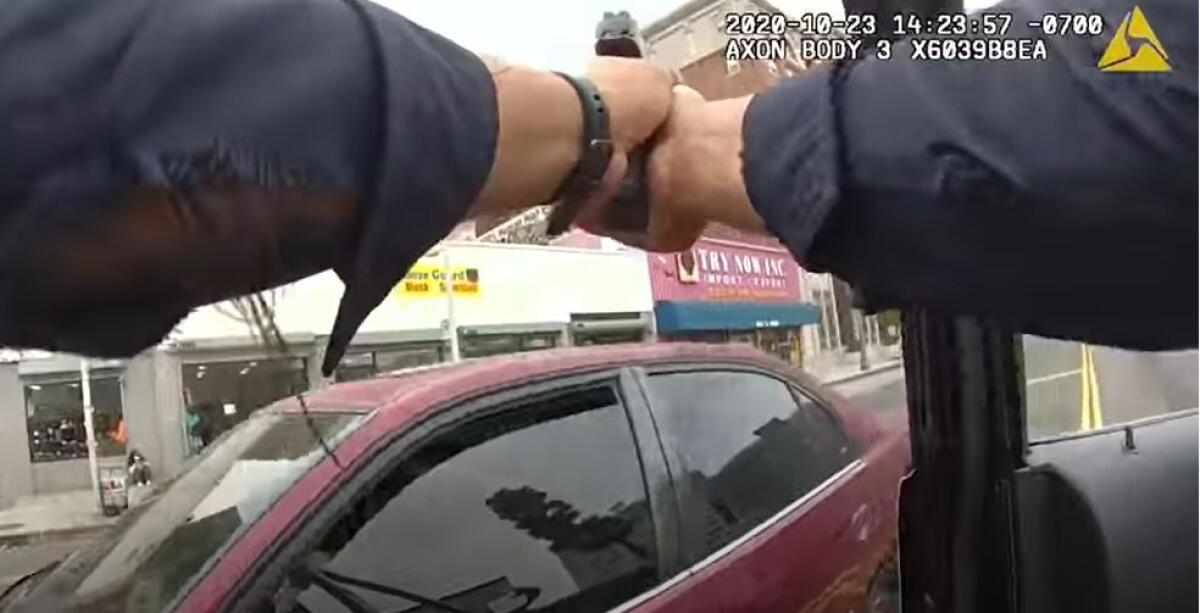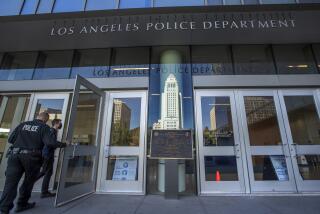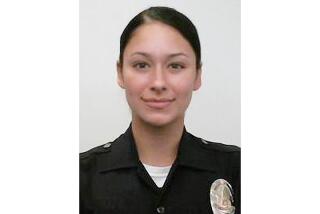LAPD officers broke policy in shootings at Paramount Pictures and downtown, panel rules

Los Angeles police officers broke policy by opening fire in two separate incidents last year, including one involving a barricaded suspect on the Paramount Pictures studio lot in Hollywood and another involving a robbery suspect downtown, the LAPDâs civilian oversight panel has ruled.
Investigators in both cases came to a strikingly similar conclusion: The officers opened fire based more on their fears than the facts around them, and put bystanders at risk in the process.
In the first incident, LAPD officers responded to the Paramount lot on the night of Oct. 18 after officers from the Fullerton Police Department requested their assistance in taking a Paramount security guard, Bryan Barrios, into custody.
Barrios was wanted on suspicion of sexually assaulting a minor in Fullerton.
When officers confronted Barrios, he began slashing at himself with a knife, saying he wanted to die and that his life was over, according to body-worn camera video released by the Los Angeles Police Department. Officers from Fullerton and Los Angeles used Tasers and beanbag shotguns to try to get Barrios to drop the knife, but neither worked.
As Barrios fled into the studio lot with a group of officers chasing him, Officer Joseph Marx fired a live round at him while other officers continued firing beanbag rounds. Barrios then ran into the studiosâ backlot â drawing the real standoff onto a fake New York City streetscape.
Barrios, who was covered in blood from his self-inflicted wounds, was eventually taken into custody near a stairwell inside one of the set buildings.
Court records from L.A. County â where an Orange County charge was consolidated â show Barrios was convicted in June of four counts related to the sexual assault of a minor and sentenced to a total of nine years in prison.
Following a two-hour standoff with Fullerton and Los Angeles police, the Orange County resident was taken into custody early Monday.
In a review of the shooting, Marx told LAPD investigators he took a shot at Barrios because he was concerned about the safety of studio staffers and the threat he believed Barrios posed to them. Barrios was not struck.
âI thought to myself, this guy is going to take a hostage, heâs going to stab one of them,â Marx said.
Investigators, however, determined that Barrios had never threatened anyone other than himself and did not represent a threat of serious bodily injury or death to studio workers. Instead, they determined Marx had placed studio employees and others in âsignificant dangerâ â including a Fullerton police detective who was running ahead of him and studio employees in a guard shack, a security booth and parked vehicles in the area.
Marx, they found, âwas focused on what could happen compared to what was actually occurring during the incident,â according to a report LAPD Chief Michel Moore presented to the Police Commission during its meeting last week.
The commission voted unanimously that the shooting was out of policy. It ruled the use of beanbag rounds and Tasers by other officers at the scene justified.
This week, the commission came to a similar conclusion in a separate downtown shooting that occurred five days after the Paramount Pictures incident.
In that Oct. 23 incident, police received multiple reports of a woman robbing businesses and pedestrians near 11th and Los Angeles streets, and responding patrol officers were directed to a woman walking down nearby Main Street with a backpack on.
Video from the scene shows the patrol officers pull up and open their doors, with Officer Erik Vivanco stepping out and telling the woman, identified as Linda Vanessa Nunez, to stop and face the wall.
A gunshot can then be heard, which investigators determined was Nunez firing at the patrol vehicle â which was hit with a bullet. Investigators said Vivanco fired one shot back at Nunez, she fired a second shot, and Vivanco then fired two more shots, according to an investigative report submitted to the Police Commission on Tuesday. Neither was struck.
All of Vivancoâs shots were justified, the commission ruled. However, another shot fired by Officer Edward Monteagudo, who had pulled up just as Vivanco and Nunez were exchanging gunfire, was not justified, the commission ruled.
According to an internal investigation and video from the scene, Monteagudo jumped out of his vehicle and almost immediately shot one round over the top of a passing car and into the front glass door of an occupied business that Nunez had just entered after tossing her handgun on the sidewalk.
In a statement to investigators, he said that he opened fire because he believed Nunez was still armed and feared for the lives of others inside the business.
âMy concern was her going into that business now puts everyone in harmâs way inside that location,â Monteagudo told investigators. âSheâs already shown the fact that she robbed stores, she shot at officers, so at this point in my mind is for her thereâs no turning back.â
Surveillance video from inside the store showed that Nunez had entered a glass-fronted entrance but that an interior metal gate was still blocking her entrance into the store. The video shows Monteagudoâs shot smash through the front glass right behind Nunez just after she entered the doors.
Investigators said they weighed Monteagudoâs concerns about the people inside with the risk posed by him firing into the glass storefront of the shop, and considered the fact that Nunez had already discarded her gun in determining that Monteagudo had acted unreasonably and violated department policy by shooting.
âThe mere possibility or fear that Nunez may present a danger to people inside the location did not present a situation where there was an imminent threat of serious bodily injury or death,â investigators concluded.
Echoing language in the Paramount Pictures case, they said Monteagudo was âresponding to what he believed could possibly occur, as opposed to what was actually occurring.â
After Monteagudo fired at Nunez, the woman quickly walked outside with her hands up and surrendered.
âIâm pregnant. I was just hungry,â she said as she was handcuffed on the ground.
Nunez was taken into custody and charged by prosecutors with attempted murder, robbery and firearms charges. She could not be reached for comment but has pleaded not guilty to the charges against her, according to court records.
The Police Commission voted Tuesday that the shooting was out of policy, concurring with Moore.
What punishment, if any, will be handed down to Monteagudo for breaking policy in the shooting is unclear. The departmentâs disciplinary process is generally not public.
Also unclear is the ultimate punishment that Marx will face in the Paramount case, though some actions by the department in response to the shooting are known thanks to a lawsuit Marx has filed.
In July, Marx sued the city of L.A. and Moore over a decision by Moore to follow the recommendation of a hearing officer to downgrade Marx by one paygrade tier after the shooting.
Marx alleged in the lawsuit that the downgrade had come before the LAPDâs Force Investigation Division, which investigates police shootings, had completed its investigation into the shooting.
âNo one should draw any conclusions on whether Officer Marx acted consistent with LAPD policies and the law until all the facts were known and the investigation completed,â the lawsuit states.
Itâs not immediately clear what impact the Police Commissionâs ruling that Marx was in violation of department policy will have on the lawsuit.
More to Read
Sign up for Essential California
The most important California stories and recommendations in your inbox every morning.
You may occasionally receive promotional content from the Los Angeles Times.











